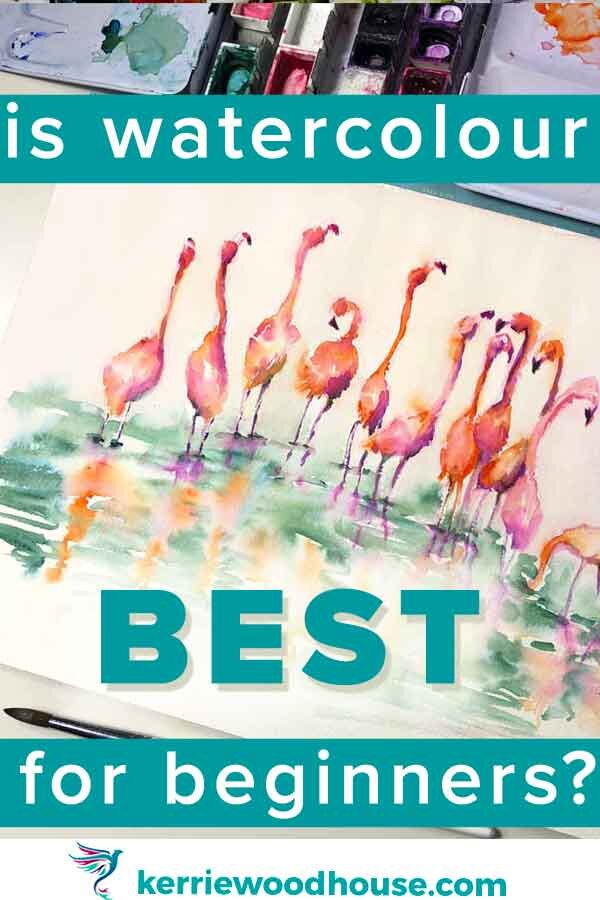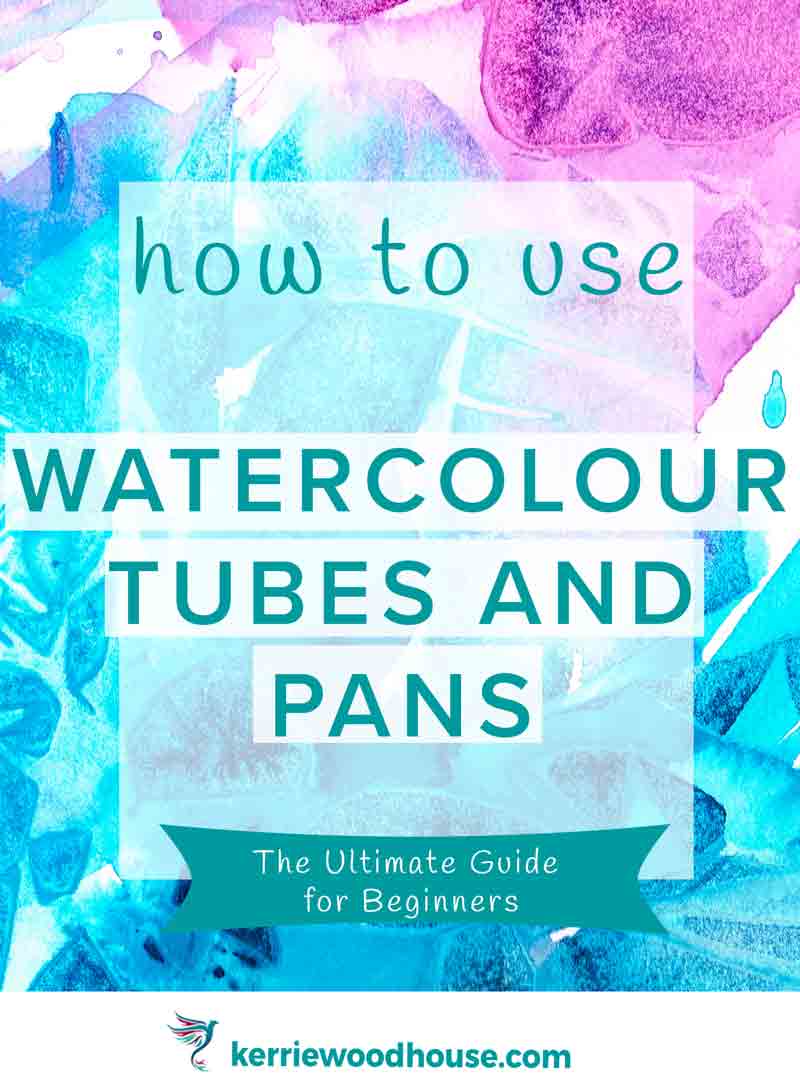Is Watercolour the Best Medium for Beginners?
For a beginner, a painting medium needs to be attractive, approachable and a relatively low investment, both of time and money. Watercolour is a good medium for beginners for all those reasons.
When it comes to looking for an attractive medium, I mean the sort of painting that appeals to you. There is no point learning watercolour painting if you don't enjoy the look and feel of watercolour artwork.
Approachability is important because a beginner faces quite a few hurdles, so a medium that offers less barriers to entry is very significant.
That brings me to cost. When you start a new hobby you want to be able to give it a bit of trial without having to spend too much time or money figuring out if this is something you are likely to pursue.
In my view, watercolour ticks all of those boxes.
I want to explain in a lot more detail, but before I do there is an important question that you are probably asking…
Is Watercolour Painting Easy?
Watercolour also has a reputation for being a difficult medium to learn. Isn’t that interesting? The most common recommendation for beginners also has a name for being one of the trickiest to master.
This is because watercolour relies on water and therefore has an unpredictable quality to it. I love that. It does mean however that if your intention is to control every bit of your painting that you will have a hard time of it. My answer to this is always the same. Why would you want to? The wilful nature of watercolour is part of its charm. Why try to control it when you can just collaborate with it instead?
I have a whole class for beginners based on this very premise - that you can learn to paint with watercolour the EASY way, by collaborating with it instead of trying to control it.
Another quirk of watercolour painting is that there is no white paint in the purist’s watercolour palette. Watercolour paint is transparent and applied to white paper. That means that the highlights are the paper and need to be preserved since you can’t paint lighter colours on top of darker colours like you can with gouache, acrylic and oils.
Once you get used to this, the white parts of a watercolour painting are another one of its glories. Those little flashes of bare paper give a sparkle and liveliness that is hard to capture any other way, in my opinion.
The Advantages of Watercolour as a Beginner’s Painting Medium.
Watercolour often is the primary choice for a beginner. There are a lot of good reasons for that.
Let me elaborate on the advantages of watercolour as a painting medium.
Cost Benefits of Watercolour Painting
A huge advantage of watercolour as a beginner painter’s medium is that you need very little in the way of supplies to get started.
A small selection of watercolour paints, a nice soft brush and some watercolour paper.
By the way, I have a whole class on watercolour supplies - it’s free, and you can sign up here.
The Beginner’s Guide to Watercolour Supplies
Solvent Free Benefits of Watercolour Painting
The only medium that watercolour paints require is water.
Oil paints need thinners and solvents. Even acrylics can come with a range of additional mediums to add for different effects, such as impasto medium to give thicker texture to the paint, if you happened to purchase a fluid acrylic rather than a heavy body acrylic. Or a flow medium if you purchased thicker paint that you want to thin down.
Traditional oil painting requires solvents to thin the paint and clean the brushes. The chemicals in these solvents, and in the oil paints themselves can be harsh and toxic. To work with traditional oils and solvents you do need a well ventilated spaces and probably a good pair of latex gloves.
Extra oil, such as linseed or walnut is often added to the paint to alter its consistency. Mediums are available to slow the drying time of acrylics and there are others available to speed up the drying time of oil paints.
Watercolour needs none of this extra stuff.
There is beauty (and relief) in simplicity.
If you want to find out more about watercolour paint properties and how to use them, this article is your Ultimate Beginner’s Guide.
By the way, if you are keen on oil painting, but put off by the solvents there are water mixable oils available that you might want to investigate. Here’s a video of me painting with water mixable oils. I might be a total watercolour enthusiast but I am still open minded!
Easy Clean Up
I am a bit of a messy painter. It’s part of the fun, right?
I like to splash the paint about a bit. Luckily, watercolour is easy to clean up with a damp cloth. I do have one or two colours that are what are known as staining colours and if I have let those dry on my white art table they can be a little more tricky to get off.
Discover more about the properties and characteristics of watercolour paints in this article.
But on the whole, cleaning up from a painting session involves nothing more than flipping the lid on my palette box shut and swishing my brush in some water to rinse it off.
What’s not to love?
Space Benefits of Watercolour Painting for Beginners
With only a small selection of supplies necessary for watercolour painting you also do not need a lot of space. There is no large easel required, and finished paintings are on flat pieces of paper which makes them easy to store.
Watercolour dries very quickly. Unlike an oil painter who needs to be able to house a wet oil painting for weeks (and often months) your finished watercolour paintings can be put away the same day.
The Benefit of Paper Based Art for Beginners
I have to say that working on paper has been important for me throughout my art journey so far. Canvases are expensive, cumbersome and difficult to store.
When you face the blank new pricey canvas you are immediately under more pressure not to ‘mess it up’. Feels wasteful.
A piece of paper (admittedly it must be proper watercolour paper) is far more user friendly. Here are some more details on how to choose the right watercolour paper for you. In my opinion, the paper is the most important supply choice you need to make.
If you decide to chuck out an old painting this feels so much easier if it is just a bit of paper and not a whole stretched canvas or panel.
Another benefit of being paper based is the ability to work in a sketchbook. That is both liberating and portable. Can’t recommend it enough.
To be fair, this is not just an advantage of watercolour. Any quick drying medium like gouache or acrylics (or dry medium such as coloured pencils) obviously enjoys the same benefits.
The Disadvantages of Watercolour as a Beginner’s Painting Medium
As you can see, watercolour has a lot going for it as a beginner’s (or an expert’s) painting medium. But let’s take a look at the other side of the fence for a moment.
Presenting Finished Watercolour Paintings
Now this is one of the disadvantages of watercolour. An oil or acrylic painting on a stretched canvas or panel is ready to hang, as it is. Watercolour paintings need to be protected from light.
Watercolour paintings also require a sturdy backing since they are just on a sheet of paper. This is why a finished watercolour painting requires the extra step of mounting and framing under glass.
The mount keeps the glass from coming into direct contact with the painting (and looks wonderful). It is possible to mount paintings on panels or even canvases for a more contemporary look, but a glass frame is the simplest option.
Are Watercolour Paintings of Lower Value?
Watercolour often gets a bad rap. I think part of this is that since it is often the first port of call in beginner art courses, a perception is sometimes created that it is just a starter medium on the way to ‘proper’ art.
Contrast this with the view that watercolour is one of the hardest mediums to work with and then form your own opinion. 😉
Finished oil paintings are often perceived as higher value artwork than finished watercolour paintings, and often sell for higher prices. As a beginner, selling your paintings is probably not a particular concern but if this perception is in the back of your mind it may be colouring your whole experience of learning to paint with watercolour.
I think that if you do hold that view, then perhaps you would be better off beginning with another medium. Every artist criticises their own work - and usually far more harshly than anyone else.
If you have a negative view of watercolour painting in general and are only pursuing it as a gateway to another medium then I think you are making your art journey far more tortuous than it needs to be. If you are feeling critical of your beginner paintings in a medium that you consider to be preliminary then you are likely to be miserable and discouraged very quickly.
Art is fun.
It is one of the most relaxing and rewarding pastimes I can think of.
Choose a medium that gives you the best chance of experiencing that for yourself.
Are you on your own painting journey?
One of these might be useful…














